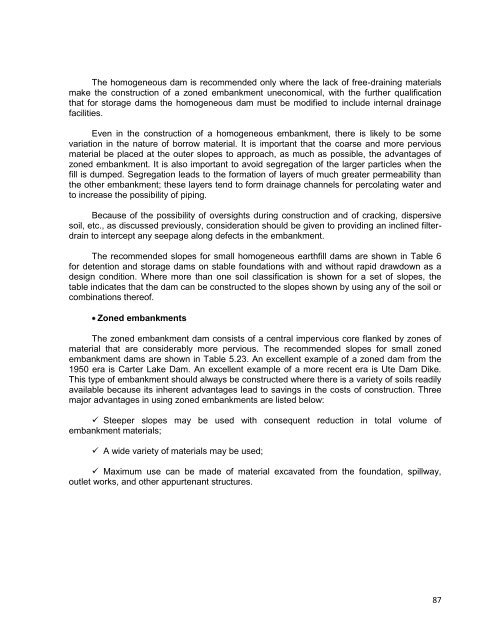SMALL DAMS PETITS BARRAGES
SMALL DAMS PETITS BARRAGES
SMALL DAMS PETITS BARRAGES
- TAGS
- dams
- petits
- barrages
- cbdb.org.br
Create successful ePaper yourself
Turn your PDF publications into a flip-book with our unique Google optimized e-Paper software.
The homogeneous dam is recommended only where the lack of free-draining materials<br />
make the construction of a zoned embankment uneconomical, with the further qualification<br />
that for storage dams the homogeneous dam must be modified to include internal drainage<br />
facilities.<br />
Even in the construction of a homogeneous embankment, there is likely to be some<br />
variation in the nature of borrow material. It is important that the coarse and more pervious<br />
material be placed at the outer slopes to approach, as much as possible, the advantages of<br />
zoned embankment. It is also important to avoid segregation of the larger particles when the<br />
fill is dumped. Segregation leads to the formation of layers of much greater permeability than<br />
the other embankment; these layers tend to form drainage channels for percolating water and<br />
to increase the possibility of piping.<br />
Because of the possibility of oversights during construction and of cracking, dispersive<br />
soil, etc., as discussed previously, consideration should be given to providing an inclined filterdrain<br />
to intercept any seepage along defects in the embankment.<br />
The recommended slopes for small homogeneous earthfill dams are shown in Table 6<br />
for detention and storage dams on stable foundations with and without rapid drawdown as a<br />
design condition. Where more than one soil classification is shown for a set of slopes, the<br />
table indicates that the dam can be constructed to the slopes shown by using any of the soil or<br />
combinations thereof.<br />
Zoned embankments<br />
The zoned embankment dam consists of a central impervious core flanked by zones of<br />
material that are considerably more pervious. The recommended slopes for small zoned<br />
embankment dams are shown in Table 5.23. An excellent example of a zoned dam from the<br />
1950 era is Carter Lake Dam. An excellent example of a more recent era is Ute Dam Dike.<br />
This type of embankment should always be constructed where there is a variety of soils readily<br />
available because its inherent advantages lead to savings in the costs of construction. Three<br />
major advantages in using zoned embankments are listed below:<br />
� Steeper slopes may be used with consequent reduction in total volume of<br />
embankment materials;<br />
� A wide variety of materials may be used;<br />
� Maximum use can be made of material excavated from the foundation, spillway,<br />
outlet works, and other appurtenant structures.<br />
87














